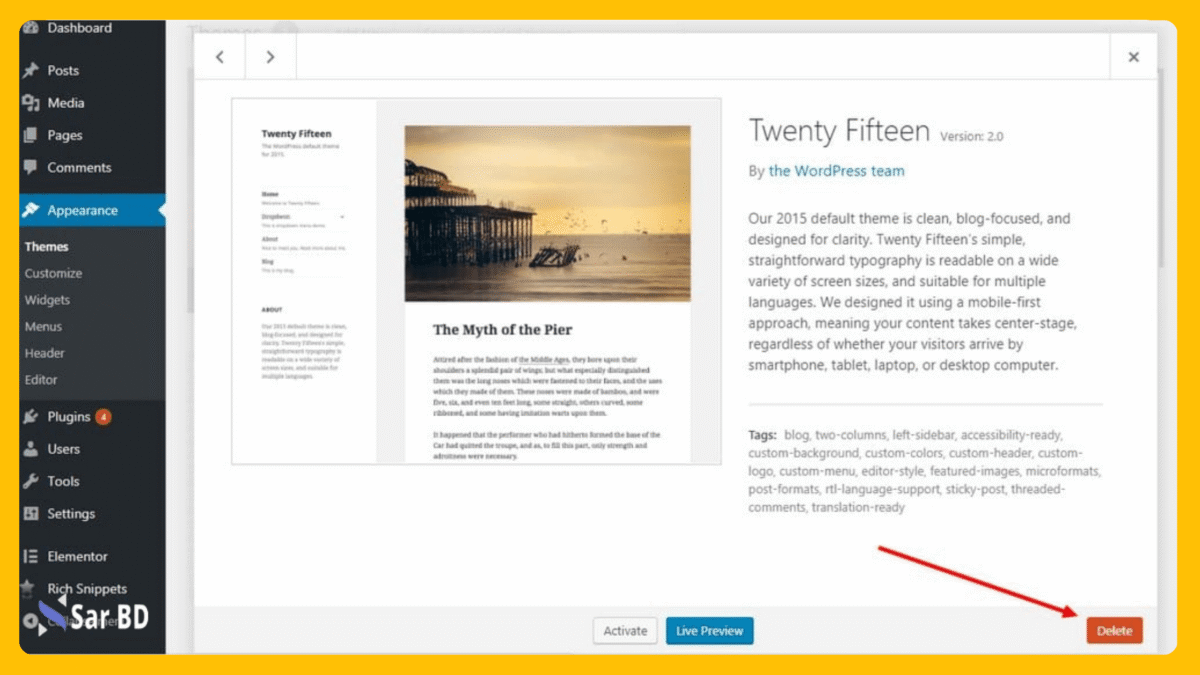How to Remove Theme in WordPress
Introduction: Understanding the Importance of Removing Unused Themes
If you’re managing a WordPress website, chances are you’ve experimented with different themes to find the perfect fit. While testing themes can be an exciting part of the design process, many users forget to remove the unused ones afterward. Knowing how to remove theme in WordPress is more important than you might think. Unused themes not only clutter your dashboard but also pose potential security risks and can slow down your site. In this comprehensive guide, we will walk you through every step of how to remove theme in WordPress, and explain why it’s crucial to keep your WordPress environment clean and optimized.
Learning how to remove theme in WordPress doesn’t require advanced technical knowledge. It’s a simple process once you understand the methods and precautions involved. Whether you’re a beginner or an experienced webmaster, this guide will help you maintain a lean, fast, and secure website by properly managing your WordPress themes.
Why You Should Remove Unused Themes
- Improve Website Performance
Every installed theme consumes server space and may include background processes or files that load unnecessarily. While one theme may not significantly impact performance, multiple unused themes can accumulate clutter. Over time, this can slow down both your dashboard and front-end performance. Learning how to remove theme in WordPress ensures your site stays light and fast. A clean backend also means faster updates and better workflow efficiency. With fewer themes to manage, server resources are allocated more effectively. Removing unused themes supports a more optimized digital environment. - Enhance Security
Unused themes are often overlooked when it comes to updates. Outdated themes may contain vulnerabilities that hackers can exploit, even if the theme is inactive. By understanding how to remove theme in WordPress, you reduce your site’s attack surface. Cybersecurity should never be underestimated, especially with WordPress being one of the most targeted CMS platforms. A lean list of active components is easier to maintain and secure. Avoiding unnecessary themes strengthens your security protocols. Routine theme audits and removals help eliminate potential risks. - Easier Site Maintenance
Managing your WordPress site becomes significantly easier when it’s not cluttered with unused themes. Routine updates, backups, and troubleshooting are simplified. When you know how to remove theme in WordPress, you’re better equipped to streamline your site’s backend. This is especially useful for developers and webmasters handling multiple client sites. Clear organization minimizes the chance of activating or modifying the wrong theme. It also speeds up debugging and reduces confusion during development. Efficient maintenance leads to a better user and admin experience. - Reduce Database Bloat
Although inactive themes don’t directly impact your live site, they can leave behind data entries in your WordPress database. This includes theme options, settings, and other metadata. Understanding how to remove theme in WordPress helps prevent your database from becoming bloated with unnecessary data. Over time, a cleaner database improves site speed and reduces storage needs. It also leads to quicker backups and restorations. Keeping your database light makes overall site management more efficient. Regular cleanup should be part of your maintenance routine.
Backup Before You Remove a Theme
- Ensure a Safety Net Before Making Changes
Before taking any major action on your website, including removing a theme, it’s vital to create a full backup. Understanding how to remove theme in WordPress safely begins with having a fallback in case something goes wrong. A backup protects your content, settings, and customizations. Even though removing a theme is typically safe, errors can occur due to plugins or dependencies. Using a backup plugin like UpdraftPlus or BackupBuddy makes this task easier. Store your backups in multiple locations, such as cloud storage and your local device. Having a reliable backup means you can restore your site quickly. It ensures peace of mind while making backend adjustments. - Backup Both Files and Database
A complete backup involves not just your theme files, but also your WordPress database. This includes posts, pages, settings, and configurations. Learning how to remove theme in WordPress properly means taking all data into account. You can use your hosting provider’s backup tool or a plugin to ensure everything is captured. Don’t overlook the wp-content folder, where themes and plugins reside. A full backup is your safety shield against accidental loss. This is especially important if you’ve made custom edits to a theme you’re about to remove. Backups are essential for responsible website management. - Test Your Backup
After creating a backup, it’s wise to test it before proceeding. This verifies that the files and database were saved correctly. Knowing how to remove theme in WordPress includes understanding how to verify your safety measures. Try restoring the backup on a staging site or local development environment. Ensure all functionality is intact, and that no data is missing. This step minimizes the risk of irreversible changes. It’s an extra layer of confidence before deleting anything. Testing your backup ensures you’re fully prepared for any unexpected outcome.
Different Methods on How to Remove Theme in WordPress
- Removing a Theme from the WordPress Dashboard
The easiest and most beginner-friendly way of how to remove theme in WordPress is directly through the dashboard. Go to Appearance > Themes, and you’ll see all installed themes. Click on the theme you want to remove and select “Delete” from the bottom-right corner. WordPress will ask for confirmation, and once accepted, the theme will be removed. This method is suitable for users who manage their site through the admin interface. Make sure the theme you’re deleting is not the active one. If it’s active, switch to another theme first. This process is intuitive and safe for most users. - Removing a Theme via FTP or File Manager
If you don’t have access to the dashboard or prefer a manual method, you can delete the theme using FTP or your hosting provider’s File Manager. Connect to your server and navigate to wp-content/themes/. Find the folder corresponding to the theme you want to remove and delete it. This method of how to remove theme in WordPress gives you direct control over your site’s files. It’s particularly useful if your site is experiencing issues that prevent dashboard access. Always double-check you’re deleting the correct folder. Manual deletion requires more caution but offers flexibility for advanced users. - Using WP-CLI to Remove a Theme
For developers and advanced users, WP-CLI (WordPress Command Line Interface) offers a fast way to remove themes. Once you have WP-CLI installed, use the commandwp theme delete theme-name. Replace “theme-name” with the actual directory name of the theme. This method of how to remove theme in WordPress is ideal for automation and managing multiple sites. WP-CLI reduces reliance on the WordPress admin interface and speeds up workflow. It’s also scriptable, making it excellent for agencies or developers maintaining many WordPress installations. Ensure you have the correct permissions and backups before using WP-CLI.
What Happens After You Remove a Theme?
- Cleaner WordPress Installation
Once you’ve successfully removed a theme, your WordPress installation becomes cleaner and more organized. Understanding how to remove theme in WordPress contributes to better site hygiene. With fewer files and less clutter, managing updates and backups becomes more efficient. This cleanliness also enhances the performance and stability of your site. Having only the necessary themes installed minimizes confusion and potential conflicts. It provides clarity when troubleshooting or developing new features. A streamlined setup leads to improved productivity. - Reduced Risk of Conflicts
Each theme can potentially introduce code that conflicts with plugins or core WordPress files. After learning how to remove theme in WordPress and deleting unused themes, you reduce the risk of these conflicts occurring. Your site becomes more stable and consistent. Removing unused themes ensures that only trusted, well-maintained themes are present. This lowers the chance of accidental errors or bugs. Overall, it contributes to a more robust WordPress environment. - No Impact on Active Theme or Content
Deleting a theme does not affect your current theme or any of your content. This is a common concern for beginners learning how to remove theme in WordPress. As long as you’re not deleting the active theme, your site will remain fully functional. Themes do not store actual content; they only control design and layout. Your posts, pages, and media are safe. Removing inactive themes is safe and recommended. Just double-check that the active theme remains untouched.
Frequently Asked Questions (FAQs)
- Can I reinstall a theme after deleting it?
Yes, you can reinstall a deleted theme anytime from the WordPress repository or by uploading the theme files. Understanding how to remove theme in WordPress includes knowing that deletion is reversible. - Will deleting a theme delete my content?
No, deleting a theme does not delete your website content. Content is stored in the database, separate from theme files. - What if I accidentally delete the active theme?
WordPress will default to another available theme. If no other themes are installed, your site may break until a new theme is installed. - Should I keep one default theme installed?
Yes, it’s recommended to keep one default WordPress theme (like Twenty Twenty-One) as a fallback in case your active theme fails. - How often should I check for unused themes?
Check for unused themes during major updates or routine maintenance — ideally once every quarter.
Conclusion: Stay Clean, Stay Secure
Mastering how to remove theme in WordPress is a simple yet essential task for maintaining a clean, secure, and high-performing website. Whether you’re running a personal blog or managing dozens of client sites, knowing how to identify and safely delete unused themes will enhance your WordPress experience.
By removing clutter, reducing security vulnerabilities, and optimizing performance, you set your website up for long-term success. Don’t underestimate the power of a tidy backend — it’s just as important as the content your users see.
Take action today: log in to your WordPress dashboard, audit your installed themes, back up your data, and remove anything that’s no longer in use.
Your website (and your future self) will thank you.


